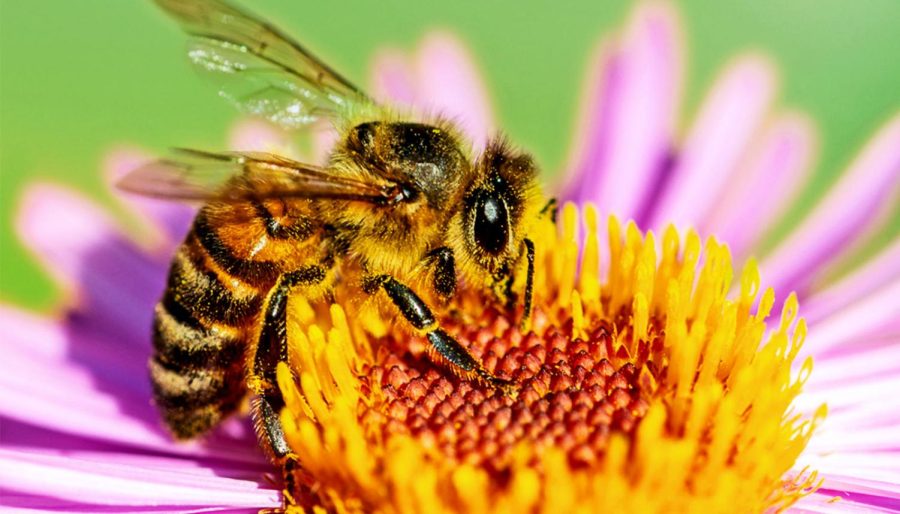The Stinging Truth of Dwindling Bee Populations
May 11, 2022
We are lucky to live on a planet with such diverse environments and ecosystems. We get to enjoy the true beauty of nature and the wonders that lie within it. However, I cannot say the same about our gratefulness for how this nature comes to be. While most appreciate our planet’s coveted animals like monkeys, bears, eagles, and lions, we overlook some of the smaller creatures the Earth has to offer. There are unsung heroes flying under the radar, heroes that are critical to the maintenance of Earth’s ecosystems. I say flying quite literally. These heroes are the bees, an underappreciated contributor to the environment, but one that is integral to the nature we see in front of us. While you might not understand the buzz of these little creatures, I assure you that there is plenty to be excited about.
The reason bees are so important to our ecosystem lies within their role as pollinators: creatures that are responsible for the transportation of pollen from male flowers to female flowers. They have a vital role in our ecosystem for the development and spread of our plants. “One bee colony is capable of pollinating 300 million flowers every single day,” according to greenpeace.org. Greenpeace also explains that “one out of every three bites you put in your mouth was pollinated by honeybees.” They are the reason we can grow crops effectively and have the food resources we need to survive. It’s unquestionable that they play an integral role in our environment, and that’s where our problem begins. Bee populations are falling, and falling fast.
According to ABC News, “the honey bee population decreased 40% in the winter of 2018 to 2019 alone, and the annual rate loss for the 2019 to 2020 winter was also 40%.” This rate of population decrease is alarming, and is the opposite of sustainable. If the bee population were to continue to trend in this direction, there would be catastrophic results on our resources, environment, and economy. While the economy collapsing just because of a small insect could be hard to believe, there is evidence that shows there is plenty to be worried about.
Let’s take a look at a hypothetical future with no bees: a trip to your local supermarket. The glass sliding doors open swiftly to reveal… emptiness. Shelves that were once plentiful with vibrant fruits and vegetables are now only stocked to half capacity. Products like almonds, apples, corn, and broccoli would be close to nonexistent. You reach for your wallet, prepared to pay for the sad groceries that now sit in your cart. Once again, emptiness. Without the vital role of the bees being played, the failed agriculture would lead to a complete destruction of our global economy. According to Forbes, “between $235 and $577 billion (U.S.) worth of annual global food production relies on [bees’] contribution.” With another look around, there is realization that a future with no bees is hardly a future at all. This is the crisis.

So why have the bees been dying at such an alarming rate? While many say that the mystery behind the population decrease is a cold case, that is just the effect of PR efforts from big chemical companies. According to greenpeace.org, “biologists have found more than 150 different chemical residues in bee pollen,” revealing the true effect of pesticides and other chemicals on the disappearance of bees. According to science.org “The pesticides are commonly coated onto seeds to protect them from soil pests; when the seed germinates, the pesticide is absorbed and spreads through the tissue. It eventually reaches pollen and nectar, which is how pollinators are exposed.” Our methods of agriculture have been destructive on our ecosystem, threatening to eliminate some of our world’s most important species.
Although we have made countless mistakes in the past when it has come to our attention to our planet’s bee population, it is never too late to implement changes in our ways to protect them and our ecosystem. According to science.org, in 2017, “the European Commission proposed extending the ban of three neonicotinoids—clothianidin, imidacloprid, and thiamethoxam—to all field crops, because of growing evidence that the pesticides can harm domesticated honey bees and also wild pollinators.” This is definitely a move in the right direction, and any action taken against these pesticides will be a major contribution to the protection of our world’s bees.
Now that their importance to our planet is obvious, it’s time we rise up and take action against their disappearance. Let’s save the bees!
(Are you interested in learning more about the protection of bees? Consider visiting these websites!)
Save the Bees – greenpeace.org
Save the Bees – enviornmentamerica.org


















































































































































